Nyerere National Park (Selous Game Reserve)
In late 1997, I went out to the Selous Game Reserve in Tanzania. Located about 200 km south of Dar es Salaam in the interior, it is said to be one of the largest animal sanctuaries in the world, even larger than the famous Serengeti. I was there for only three days, though, so I only barely scratched the surface. I will show you an introduction to the Selous Game Reserve, with plenty of photos.
Safari tours in Selous Game Reserve
Quite a few tours of Selous Game Reserve are conducted. To join in one of the tours, you should go either to Zanzibar or Dar es Salaam. Although there are day-tours to visit Selous Game Reserve, I recommend you to stay there for three days.
The most common way to get to the Selru game reserve is to fly in from Dar es Salaam. This is due to the high water level and poor road conditions in the Selous area.
To Selous
.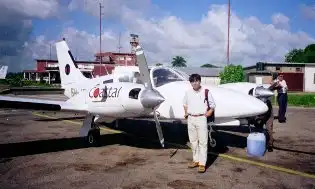
The flight from Dar es Salaam to Selous is a small plane flown by a company that specializes in charter flights. We were told that the flight would check in at 8:30 and depart at 9:00, but when we arrived a little earlier, we found that we were the only two people on the plane. We were told that we could check in at 8:30 and that the flight would depart at 9:00. However, when we went to the plane and suddenly started to fill up with fuel, it was no different from a cab in Tanzania. The plane was a twin-engine, six-seater, but I don't know what model it was.
With fuel ready, the plane took off. The airport in Dar es Salaam has one runway for everything from jumbo jets to Cessnas. Leaving Dar es Salaam, the plane flew just above cloud level and landed about 40 minutes later on a high, unpaved runway at the edge of the river.
Rufiji River Camp
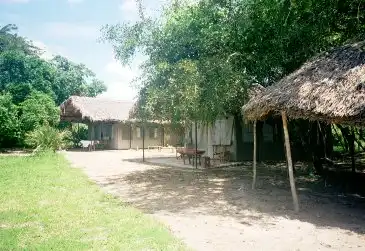
As soon as the plane landed, I don't know if it was a radio call or simply the sound of the plane's propeller, but a Land Rover came along. This is the pick-up from Rufiji River Camp in Selous.
As the name suggests, Rufiji River Camp is located on a hill beside the Rufiji River. It was less than a short drive from the airstrip. It is what is called a "tented lodge", where you stay in a built-in tent. The tents have a simple roof over them, and there are flush toilets and showers in the rear. The ten tents can accommodate only 20 people.
Boat Safari
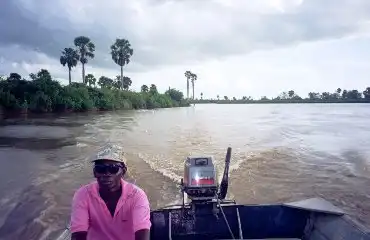
What you probably won't experience in any other park in Tanzania is a safari on a boat on an intricate river. The boat ride in Selous takes about two and a half hours around the main stream of the Rufiji River and its tributaries, which flow right in front of the camp. The boat is made of aluminum with a flat bottom and can accommodate seven or eight people. It has an outboard motor in the back and looks like a flattened motorboat. On the evening of the day we arrived, we went on a boat safari as our first program.
The river water is muddy brown. The water is muddy even when it is not raining. The current is fast in some places. Anyway, the current speed is not so fast that it would be a problem to go upstream by boat. I don't know how deep the water is, but I don't think it is that deep.
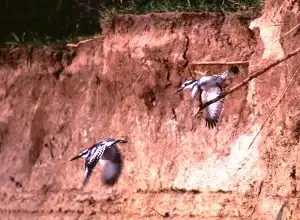
Once on the river, what I immediately noticed was the abundance of kingfishers and bee-eaters. The reason for this is that these birds build their nests in side holes in the earthen walls. The riverbanks are often bare due to erosion by the current, making them ideal nesting sites for these birds.
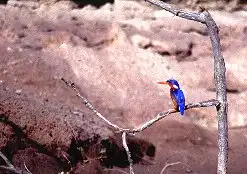
There are several species of kingfishers, but the one you see most often is called the Pied kingfisher. The African brown kingfisher is the easiest of the kingfisher species to see. In all, we saw five species of kingfishers, and there are several others.
There are quite a few hippos where the water seems a bit shallow. They float up from time to time and squirt poo-poo like whales. But since only their faces appear, it is almost impossible to photograph them. Hippopotamuses are also frightening animals when they get angry. They are so big that they can probably turn a boat upside down. It would be a big problem if they overturned the boat. There are also crocodiles, and it is said that if a hippopotamus bites you, it will cut off your arms and legs in a snap.
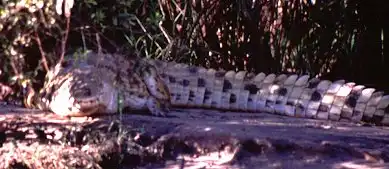
The crocodiles were occasionally seen in the water near the shore or on the shore, but the biggest ones were about a meter and a half at most. But our guide told us that there are bigger ones somewhere in the water.
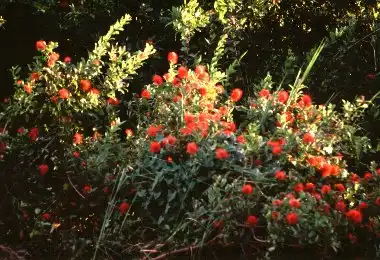
The boat enters a tributary and proceeds through a section where both banks have narrowed considerably, snagging on overgrown bushes. The most common species in this area is the weavers. They nest in the branches above the water. I remember reading somewhere that they prefer to nest above water to avoid snakes. However, with the recent rains, I saw quite a few poor nests submerged in water. I don't know what it is called, but there are red flowers on the trees on both sides.
The boat continued on and we came to a wide open area again. The thick trunks and tall palms lined up in a row looked like a Greek or Roman temple. There was an Italian couple on the boat, and I thought of saying to them, "It looks like the Foro Romano (a large archaeological site in Rome). But neither of them seemed to understand English at all, and I didn't want to make them feel uncomfortable on the boat because they didn't understand me.
Hot and Long Day
The day dawned on January 2. This is the day of the car safari. If it is a safari by car, it is not much different from those in Arusha, Ngorongoro, Serengeti, and other parks I have visited before. However, there is one big difference. That is the vehicles used for safaris. In other parks, safari vehicles are usually four-wheel-drive vehicles with a large opening in the roof. However, the vehicle used here was just a pickup Land Rover with a frame attached to the back of the vehicle. There is no roof. No doors. No walls. It's a very dynamic place, but I wonder what would happen if it rained. More importantly, what would happen if a lion attacks?
Well, whatever the case, we are off. We grab our packed lunches and begin our nine-hour safari, which will last from morning to evening.
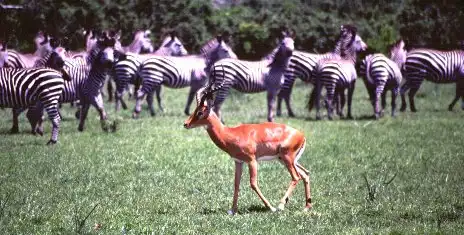
The first to appear was an impala. They are a small antelope species. They live in large herds. They seem to prefer areas with trees rather than grasslands, so they formed a large herd in an area with a lot of bushes.
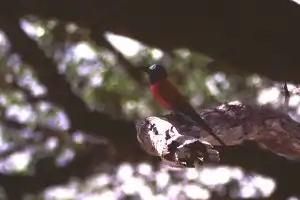
The car keeps going and going. We saw several rare bird species along the way. The photo is a Carmine Bee-eater, which I had always wanted to see. Unfortunately, the photo of a Turaco, a species I had never seen before, showed only its silhouette. But there were surprisingly few animals. The green grass is growing everywhere now because of the rain, so they may have scattered. We spotted a vulture dancing, and when we got closer, we found lion tracks. And a dead baby elephant. It seemed to have been attacked the day before. But we couldn't see any lions around.
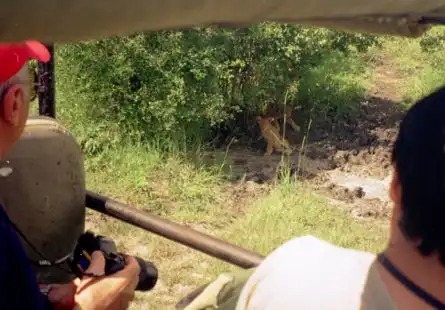
After such a big catch, I wondered if the lion would lie down in the thicket for a while and not be seen, but when I went further, there it was. I wondered if they would lie down in the thicket for a while and not be seen after such a big catch, but I went on further and there they were.
The ones in the shade. You can see that there is nothing blocking us from the lions.
Because they were all kids, I was able to say "how cute" without feeling nervous, but if there had been a big male lion, I would have wanted to run away from him as soon as possible.
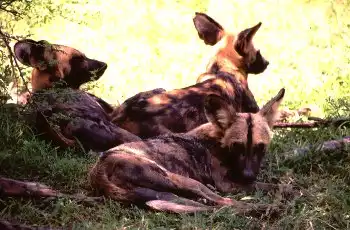
In coming to Theroux, there was actually one animal in particular that I wanted to see. It was a group of hunting dogs. In the "Kingdom of the Wild" and other TV shows I saw in the past, they called them ricaons. In the parks of Kenya and northern Tanzania, these animals have been nearly wiped out by diseases contracted from canines kept by humans. I had heard that they were in Selous, so I really wanted to see them. I had told the driver that I wanted to see it for sure, and so we did. Finally, we were able to see wild dogs. But I was the first one to find it, not the driver.
Hunting dogs are taking a nap in the shade. It was so hot! We are not allowed to go into the shade, and we have been exposed to the sun from almost directly above us on top of the roofless car since this morning. My arms already got sunburn, and my neck and the bridge of my nose are beginning to ache. The same Italian couple from the previous day was with us, and they were starting to tell the driver to go home early. It was in Italian, but I realized that they were insisting that we should arrive at 4:00 p.m., even though the driver said we would arrive at the camp around 5:30 p.m. The driver, who realized that I seemed to be understanding the conversation, looked at me and laughed. I, for my part, had seen the hunting dog and was ready to go.
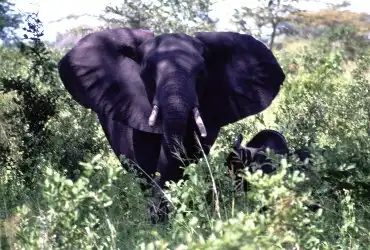
On the way back we met a group of elephants. The driver kept getting closer and closer. Mother elephants with their young are quite nervous. Of course, the drivers knew from experience how close they could get, but they were on an uncovered Land Rover. They stare at you, flap their ears nervously, and when they are finally threatened with a "Pow! I have to admit that I was chilled to the bone when he finally threatened me with "Pow!
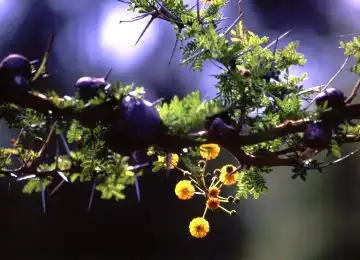
But I ended up getting a flat tire for the second time later in the day, and it was around 5:00 when we got back to the camp. The driver was not afraid to push over a tree. The tree was an acacia covered with thorns.
The thorns are extremely hard. "Why don't we collect them and export them as toothpicks?"
These thorns are so hard that when I mentioned the idea of collecting them and exporting them as toothpicks, some people objected, saying they were afraid they might get stuck in their gums. When I examined the tire I removed from the car for replacement, I found numerous thorns stuck in the tire. See the photo. The flowers are pretty like lollipops, but you can see the thorns.
Walking Safari
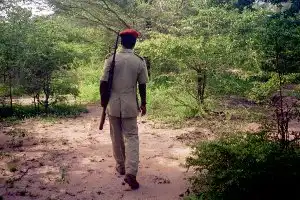
In the morning we will go on a walking safari, where we will see the animals on foot. Our guide for the day is a park ranger with a proper rifle, albeit an old-fashioned one.
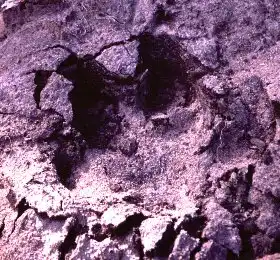
We follow him on foot to see the animals. As soon as we leave the camp, we see countless animal tracks. "This one is a hyena." "This one is a giraffe." "This big one is a hippopotamus." In Botswana, I have seen animals on foot before, but it is quite moving to realize that animals are standing right in front of you. If I had seen a lion or something, my impression would have been different.
As Ranger explained to us, there were many hyena tracks around the tent where we were sleeping. It might have been quite dangerous if we had been out at night.
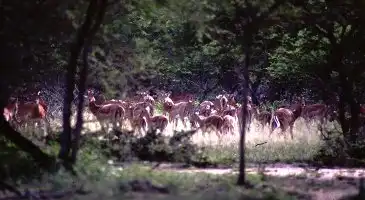
At first we were walking on grasslands with impala and other small herbivores, but gradually we entered a dimly lit forested area along the riverbank. We followed a trail full of footprints of large water-loving beasts such as hippos and buffalo. Our guide's pace slowed. He said, "This area is shady, so sometimes even in the daytime there are hippopotamuses here, and they can be dangerous." We proceeded slowly, checking our surroundings. Then we heard a rustling sound nearby. The guide keeps his eyes fixed on us, signaling with his hand to be quiet. A breathtaking moment.
The guide, who had been watching us, starts moving again, looks back at us, and says, "It's okay. It's a herd of baboons." I feel a sense of relief, and also a bit of disappointment.
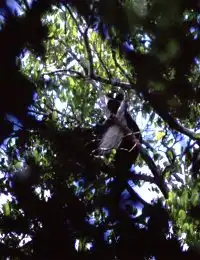
After a short distance, we came to the edge of a river. There was a large tree growing there, and on top of the tree lived a black-and-white colobus. It was difficult to see them because they were so high up, but when I patiently observed them through binoculars, I realized that they were smaller than the ones I was familiar with in Arusha National Park and looked shabby with less fur. Aafter returning from safari, I found that they were a different species.
Somewhere along the way, we entered a forest of palm trees. There were many small coconuts-like nuts on the forest floor, and some of them had sprouted. These palms are said to be edible, and not only monkeys but also herds of elephants gather to eat them when they are in abundance. He said that humans can also eat them, but not many people do so.
After walking for about 3 hours, we went out to the riverbank to be picked up by a boat for the return trip.
Return
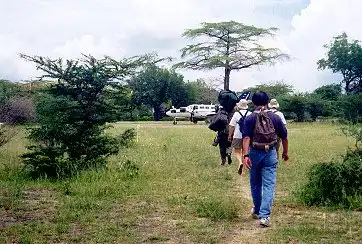
We return to camp and pack up. When I go to check out, I was told, "I'm sorry, but the plane won't be here today." "What?" I was a little surprised for a moment, but then he said, "The plane will be coming to another runway. We will take you there, but it is far away and we don't have much time. So please hurry up and get out. The flight was initially scheduled to depart after lunch, but we were given only sandwiches and were to leave immediately.
And then we thought we would be put in a car, but it was a boat again. Under the direction of the ranger, the boat went through the maze of tributaries of the river. It took about 30 minutes. I was wondering, "Is there really an airfield here? We eventually came to the shore in the middle of nowhere. After about 5 minutes of walking through the bush, we reached land. There really is a runway and an airplane! This time it was a twin-engine Cessna with a capacity of about 20 passengers. The runway is wavy and the plane speeds up step by step, it is like riding a roller coaster. As soon as we jumped out of the plane, we were on the river. The river is much larger and more complicated than I had expected. It was hard to believe that this was the scenery of Tanzania.